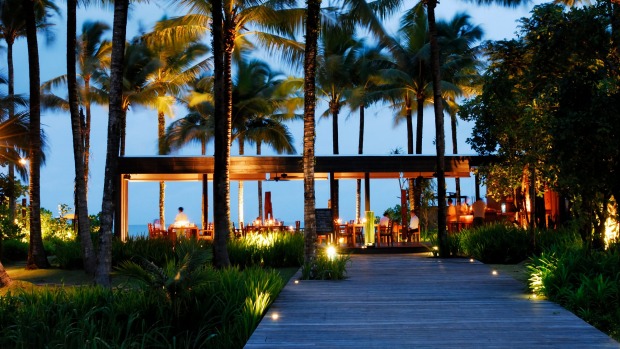
Bare concrete walls, small round tables, simple wooden chairs: the teahouse owners have clearly not wasted any funds on fancy décor. As we walk in, however, Christine Manfield's eyes light up. "This is the sort of place I would stop at if I were wandering around town by myself," says the well-known Australian chef. "No farangs, just an authentic local place."
We are here to taste-test a range of local snacks. Some, such as peanut cookies and sticky rice, are familiar. Others we have to identify the old-fashioned way: sticking them in our mouths and having a chew. There is a tasty egg custard with coconut, and sun-dried breadfruit with an almost molasses-like texture. Even the coffee, served in tall glasses over ice, tastes different.
"It's chicory," explains Christine, taking a sip. "The Thais in my kitchen used to bring in big bottles of the stuff to work."
This little teahouse – tucked into a row of Chinese shophouses in the old town of Takuapa, a low-key town in southern Thailand – is just one of the foodie experiences included in a gourmet long weekend at The Sarojin resort in Khao Lak, southern Thailand.
Think of it as a food tour in a lower gear. "We are giving a little insight into local culture," Manfield says. "The experiences are authentic and real, but the pace is more relaxing." Translation: plenty of time for massages and lying by the pool at The Sarojin.
Together with her culinary co-pilot, The Sarojin's executive chef, Chef Gogh, Manfield guides us through a string of experiences, including a visit to Takuapa's food market. Amid piles of fresh fruit and veg and tables of seafood, headscarf-draped locals ladle out portions of freshly-made curry from huge cooking pots. "This place hasn't been trampled by tourism," says Manfield. "In Phuket, you have to dig really deep to find the local culture, but here it's thriving."
The coconuts and coriander, chillies and snake beans are all familiar, but Manfield and Gogh point out little details we might otherwise have missed: a bizarre lobster-like creature with a shell like a turtle; rippling green ribbons known as stinky beans. It is not the beans that stink, Gogh assures us: the stink comes from you, after you have eaten them.
Surprisingly un-stinky are the huge slabs of gabi, or shrimp paste. The shrimp paste we know from home has a pungent smell; this is pleasantly aromatic. That is the difference between the fresh stuff and processed produce, Manfield explains. She also shows us palm sugar that is soft and golden, again unlike the processed product we get at home. Back at the resort, it is passed around in a bowl, and we eagerly spoon up mouthfuls of the sweet treat.
Gogh points out seasonal local specialities, including delicate tendrils of seaweed and tiny mushrooms that look more like funghi, which only appear during the monsoon season. Manfield scoops up bags of each; she will use them in the two grand dinners she cooks for us.
After the market, we head off to a local eatery to try kanom jeen, soft thin noodles made from fermented rice. The meal, traditionally eaten in the first half of the day, is topped with curry and a range of condiments including beans, shredded cabbage, pineapple, pickled mustard greens, cucumber and sprouts.
Gogh leads us over to the simmering curry pots and carefully points out which ones are hotter, which ones are milder. The peanut curry and the mild crab curry prove to be popular choices; one of our number accidentally opts for the hot crab curry, and is left gasping for breath.
Our most memorable meals, however, are those prepared by Manfield herself. At restaurants including Universal and Paramount, she built a reputation for flavour-packed, Asian-influenced cuisine. During two multi-course feasts, her signature style is on display in dishes such as roast barramundi with spiced beetroot and coconut tamarind sambal, and a salad of sichuan spiced duck, scallop and asparagus. Manfield is also known as a dessert diva, and her Tropicana – passionfruit curd and mango sorbet with lychees and meringue clouds – is a highlight.
This is the first time The Sarojin has hosted a gourmet weekend, but the resort's general manager, Roland Svensson, says that more are planned. "Food is at the centre of what we do," says Svensson. Aside from the resort's beachfront pan-Asian eatery and the more international Ficus restaurant, where a la carte breakfast is served until 6pm, The Sarojin already offers events such as themed wine dinners hosted by winemakers.
The resort's location in tranquil Khao Lak, around an hour away from Phuket, leaves it well-positioned to offer insights into traditional Thai food and lifestyle. "Khao Lak is not a place where you have vendors pacing the beach and tourist bars and shops lining the streets," Svensson says. "It has kept that laid back country lifestyle."
The culinary program also has a deliberately laid back pace, with plenty of free time between activities. Some participants take the opportunity to bike through the nearby national parks; most, however, devote some serious energy to chilling out, in the spa or on the beach.
Only one activity threatens to disturb the relaxed pace: a master class in street food led by Manfield. However, it turns out we aren't to expected to do any hard work: instead, we watch Manfield whip up a feast of crab fried rice, black pepper crab and hot and sour mushrooms. After the demonstration, heaped platters of the three dishes are placed in front of us. Most of us are still full from our last meal, but that doesn't stop us tucking in – it's just too good to pass up.
tourismthailand.org
Rates start at $515 per couple, per night in a Garden Residence, including all-day a la carte breakfast; see sarojin.com.
Jetstar flies direct to Phuket three times a week from Sydney and Melbourne; see jetstar.com.